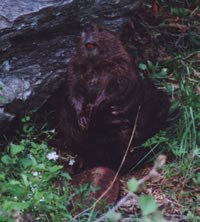
National Park Service The most commonly seen mammals in Great Falls Park are whitetail deer, Eastern chipmunks, and gray squirrels. Deer are the largest mammals found in the park, and typically give birth to one or two fawns in the spring. Does leave their fawns in one place while they go in search of food. If you find a fawn curled up in the woods, leave it in place, its mother will return for her baby. Red foxes prefer to den on slopes or underneath trees in the woods. They eat a variety of foods, including mice, rabbits, birds, berries, and seeds. Pups are typically born in March or April. Coyotes are also found in Great Falls Park. Encountering a coyote is an unlikely event, due to their shy, reclusive nature. Coyotes are known for adapting to live in many different environments and have even been seen in Rock Creek Park, located in Washington D.C.. They will eat small mammals, carrion, berries, vegetation, and sometimes birds. Coyotes help control prey populations, especially rats, which are a favorite meal. They are most active in the evening and at night. Because of that, interactions between coyotes and people are rare. Any sightings within Great Falls Park should be reported to park staff.
Nocturnal residents include raccoons, skunks, and North America's only marsupial, the opossum. Bats are active at dusk, and can be observed near the picnic areas and parking lots as they hunt mosquitoes and other insects. All wildlife is protected in the park. Observe animals from a distance, and do not feed or attempt to touch an animal. If you see an animal acting strangely, contact a park ranger. What about bears? One of the more frequently asked wildlife questions in the park is whether or not you can find bears here. Occasionally, bears will be spotted wandering into Fairfax County, usually while searching for food, new territory, or a mate. However, bears have not been observed living in Great Falls Park. If you are visiting a park or an area that has bears, remember to keep your distance. Do not approach or feed any bear, especially a female with cubs. |
Last updated: April 10, 2015
